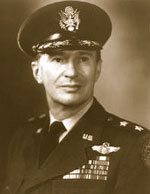Haywood S. Hansell

Amerikansk general. Chef for XXI Bomber Command i Stillehavet. Blev afløst af Curtis LeMay.
- Japan - bombardement, 1944-45
Haywood Shepherd Hansell Jr., was born in Fort Monroe, Va., in 1903, the son of Colonel Haywood S. Hansell. He graduated from Georgia School of Technology in 1924 with his bachelor of science degree in mechanical engineering.
On Feb. 23, 1928, he was appointed a flying cadet. He graduated from primary and advanced flying schools at March Field, Calif., and Kelly Field, Texas, Feb. 28, 1929, was commissioned a second lieutenant in the Air Force Reserve and assigned to active duty. He received his regular commission as a second lieutenant of Air Corps May 2, 1929.
General Hansell's first assignment was with the Second Bombardment Group at Langley Field, Va. In June, 1930, he was transferred to the Sixth Field artillery at Fort Hoyle, Md., for three months' temporary duty, and in September, 1930, returned to Langley Field as armament officer of the Air Corps Tactical School.
In August 1931, he went to Maxwell Field, Ala., where he served with the 51st and 54th School Squadrons. During that tour of duty he served with General Claire L, Chennault, then a captain in the aviation acrobatic team, "Three Men on a Flying Trapeze," which performed at the National Air Races at Cleveland, Ohio, in September, 1934.
General Hansell entered the Air Corps Tactical School at Maxwell Field in October 1934, graduated in June 1935, and became an instructor there. In September 1938, he entered the Command and General Staff School at Fort Leavenworth, Kan., from which he graduated in June 1939. He then was assigned to the Public Relations Section of the Office, Chief of Air Corps, and in September 1939, became assistant executive officer in that office.
In November 1939, General Hansell was transferred to the Inte1ligence Division in the Office, Chief of Air Corps. In 1940 he became chief of the Operations Planning Branch, Foreign Intelligence Section in that office. During July and August 1941, he served as a Special Observer at London, England, and then was assigned to the War Plans Division of the Air Staff in Washington, D.C. In April 1942, he was assigned to the Operations Division of the War Department General Staff and served on the Joint Strategic Committee.
General Hansell was assigned in August 1942, to command the Third Bomb Wing of the Eighth Air Force in Europe. The following December he became commander of the First Bomb Wing of the Eighth Air Force in that theater, and in July 1943, was named deputy commander in chief of the Allied Expeditionary Air Force. In October 1943, General Hansell was appointed Air Planner on the Joint Planning Staff at Army Air Forces headquarters, Washington, D.C. In August 1944, it was announced that General Hansell was commanding the XXI Bomber Command Based on Saipan. Planes of that command raided the industrial sections of Tokyo. General Hansell returned to the United States in January 1945, and the following month assumed command of the 38th Flying Training Wing at Kirtland Field, N.M. In June 1945, he was transferred to Air Transport Command headquarters at Washington, D.C. In September 1945, he was appointed commanding general of the Caribbean Wing, Atlantic Division, Air Transport Command, with station at West Palm Beach, Fla.
General Hansell retired with the rank of brigadier general Dec. 31, 1946.
He was recalled to active duty July 15, 1951 and assigned as chief of the Mobilization Division, Directorate of Plans, Office of the Deputy Chief of Staff for Operations at Air Force headquarters. On April 2, 1952, he was appointed assistant for mutual security in that office. In April 1953, General Hansell was appointed the senior Air Force member, Military Studies and Evaluations Division, Weapons Systems Evaluation Group, Office of the Secretary of Defense, Washington, D.C.
General Hansell has been awarded the Distinguished Service Medal, Legion of Merit, Silver Star, Distinguished Flying Cross and Air Medal. He is rated a command pilot, combat observer, and technical observer. During World War II he flew combat missions in the European and Pacific theaters.
EFFECTIVE
DATES OF PROMOTION
He was promoted to first lieutenant (permanent) Oct. 1, 1934; to captain
(permanent) May 2, 1939; to major (temporary) March 15, 1941; to lieutenant
colonel (temporary) Jan. 5, 1942; to colonel (temporary) March 1, 1942;
to brigadier general (temporary), Aug. 10, 1942; to major (permanent)
May 2, 1946; to major general (temporary) Sept. 5, 1952, with date of
rank from Sept. 2, 1947.